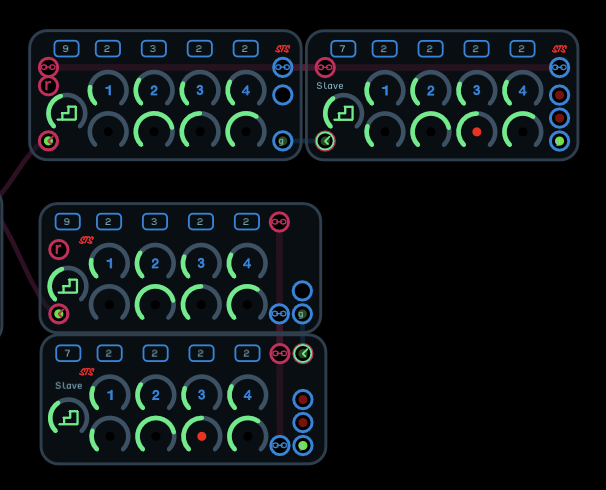In the spirit of the new library, I’m doing reface of a few of my modules. Which layout do you prefer for chain-able sequencers?

I personally would prefer horizontal since it’s easy enough to do like row of 4 of them and then chain down to another row for another 16 steps.
That makes sense. I was leaning toward horizontal myself but I couldn’t make up my mind. I thought I’d redo the whole family. I really liked your idea of a variable gate rather than just on/off so I think I’ll incorporate that into the “gate skip” version. I’m also replacing all the knobs with clamped knobs since the Windows update is now out.
I think horizontal looks better. Also all of the real life seq hardware I’ve seen is horizontal, and I think it makes sense for the app’s modules to emulate real life.
Although, now that I mention ‘emulation of real life’, perhaps you or @biminiroad can help me to understand the idea of a VCO in Audulus Module library? I cannot quite wrap my head around it, as the signals aren’t quite the same in a program in which anything can be connected to almost anything else. So what is the difference between a VCO (or really anything “voltage controlled” in Audulus) and just a regular oscillator node attached to a MIDI node?
I know as a real world module, a VCO uses 1V per octave, starting with zero, but because Audulus uses -5 <–> 5 (from what I understand atm) and a midpoint of 0, which is also the first A above middle C, thus making it a bit different, and so I have a bit of trouble grasping the concept of a ‘voltage’ anything in a virtual world that differs a lot from the concepts that are emulated a bit more realistically, seemingly, in something like VCV Rack (definitely not criticizing the system, I just want to understand better, like you do) 
All signals in Audulus are 32 bit numbers rather than the voltage values present in modular hardware. If you look at the built-in oscillator node you will see that it actually has a frequency input rather than a 1 per octave input. Similarly the keyboard node has a frequency output. You can connect the keyboard and oscillator nodes and everything works as you would expect, but if you want to manipulate the pitch of a signal, things become more difficult. In practice working with raw frequencies is rather inconvenient. By using a logarithmic scale rather than raw frequencies, a change in pitch can be accomplished by addition or subtraction. To raise a pitch an octave you simply add 1 or to lower it an octave you subtract 1. Each semitone is 1/12. The 1 per octave scale used in the Audulus library is similar in concept to the 1 volt per octave scale used in modular synths. The zero point for the modular scale is generally considered to be C0, although there isn’t an actual standard. Currently Audulus uses A4 (or A440) as its 0 reference although this may change with the introduction of Audulus 4 to bring it more into line with the modular world. Moving the 0 reference to C0 or A0 is currently under consideration. Currently A3 is -1, A2 is -2, A5 is +1 etc. There isn’t any actual limit in either direction, but of course at the low end you go subsonic (with the current scale -4 is A0 or 27.5 Hz) and at the top you go above the frequency range Audulus is capable of producing (+5 is A9 or 14,080 Hz). Since the sample rate in Audulus is currently 41 kHz, 20.5 kHz is the maximum frequency Audulus can produce.
VCO is just a shorthand for people familiar with synths. What would I call a VCA? In some senses we are emulating hardware. Not all VCOs track at 1v/oct - buchla is 0.1/semitone i think and korg’s is related to Hz.
Do you mind if I use most of that in my pitch vs frequency video?
@biminiroad They call the korg standard hz/volt and doubles voltage per octave. Commonly the scaling is 16 volts to get 5 octaves.